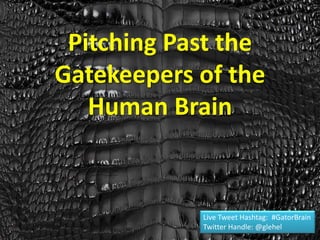Using Neuroscience To Influence People
This document discusses strategies for pitching ideas to the human brain based on its cognitive biases. It begins by outlining the three main parts of the human brain: the neocortex for logic/abstract thought, limbic system for emotions/empathy, and reptilian complex for survival/reproduction. It then notes that humans make rational decisions irrationally based on seven biases: avoiding pain/death, being self-absorbed, seeking the familiar, preferring concrete examples over abstract concepts, thinking in black-and-white terms, relying on relativity to make judgments, and relying heavily on visual processing. The document provides specific strategies to address each of these biases when presenting new ideas or concepts to appeal to the human brain.








































Recommended


























































More Related Content
Similar to Using Neuroscience To Influence People (20)












































More from Glen Hellman (7)














Recently uploaded (20)




































Using Neuroscience To Influence People
- 1. Pitching Past the Gatekeepers of the Human Brain Live Tweet Hashtag: #GatorBrain Twitter Handle: @glehel
- 3. Humans Appear 1 Mile before landing The Last Mile of 2,300 Mile Flight From LA to DC
- 4. Neocortex Human Brain Logic/Abstract Thought Limbic System Mammalian Emotions/Empathy/Parental Reptilian Complex Survival/Reproduction
- 5. Humans Make Rational Decisions Irrationally
- 8. 1. Avoid Pain/Death 2. Self Absorbed 3. Seeks Familiar 4. Concrete vs Abstract 5. Black & White 6. Relativity 7. Visual 8. Brain Fatigue
- 11. Pain & Death Strategy ŌĆó Without Pain There Is No Change ŌĆó Sell to Pain ŌĆó Frame Benefits as Loss Statements & Not Gain
- 14. Self Absorbed Strategy ŌĆó Talk Directly To Each Human In The Audience ŌĆó Hurt/Rescue ŌĆó ŌĆ£Imagine You AreŌĆØ
- 15. If YouŌĆÖre Currently Alive & YouŌĆÖve Seen It Before There Is A High Probability It DidnŌĆÖt Kill You
- 17. Seeks Familiar Strategy ŌĆó If ItŌĆÖs Revolutionary ŌĆō Analogize ŌĆó References ŌĆó Social Proof ŌĆó Safety In Crowds
- 18. Former Chief Marketing Officer USSR Joseph Stalin ŌĆśWhen one dies, it is a tragedy. When a million die, it is a statistic.ŌĆÖ
- 24. Sales Methodologies Competitive Chart Factor PSS Spin Nueroselling Agreeable ’üä ’üä ’üā Reliable ’üä ’üä ’üā Effective ’üä ’üä ’üā Efficient ’üä ’üä ’üā Expedient ’üä ’üä ’üā
- 25. Black & White Strategy ŌĆó Pile On! ŌĆō Reference Stories ŌĆō Product Comparison ŌĆō The Kitchen Sink
- 26. The Mind Is A Relative Engine
- 27. Julie was an adequate student. She spent more time during schools volunteering & championing social issues than on her studies. What does she do now? 1. Dental Hygienist 2. Bank Teller 3. Librarian 4. Dental Hygienist with 3 Kids 5. Bank Teller who Volunteers for the ACLU 6. Librarian & Avid Cyclist
- 28. Relativity ŌĆó 30,000 car delivered ŌĆó 29,500 drive 200 miles ŌĆó $500 Choice A: Car Delivered To Your Home $50,000 Choice B: Drive 1 Hour To Buy A Car $49,500
- 31. Visual
- 34. Brain Energy Use The Most Energy Hungry Human Organ The Brain Uses 20% Of Our Resources
- 35. Hybrid Brain
- 37. Brain Fatigue Strategy ŌĆó Give Your Most Important Point 1st & 2nd Most Important Last ŌĆó Break Your Presentation Up Into Little Mini Presentations ŌĆó Use Pattern Interrupts ŌĆó Meal Time Scheduling
- 39. Lessons 1. Avoid Pain/Death 2. Self Absorbed 3. Seeks Familiar 4. Concrete vs Abstract 5. Black & White 6. Relativity 7. Visual 8. Brain Fatigue



